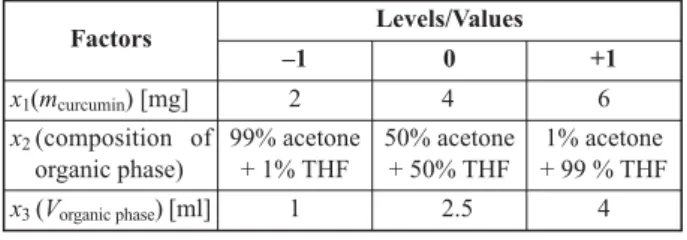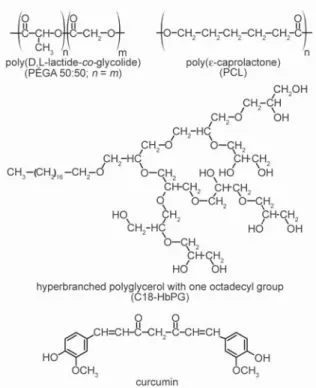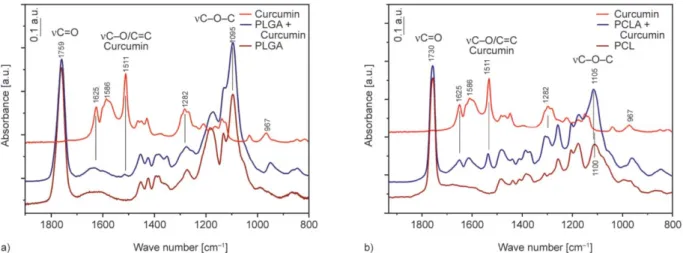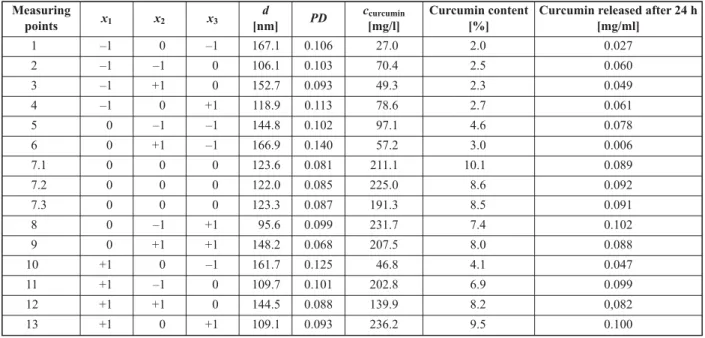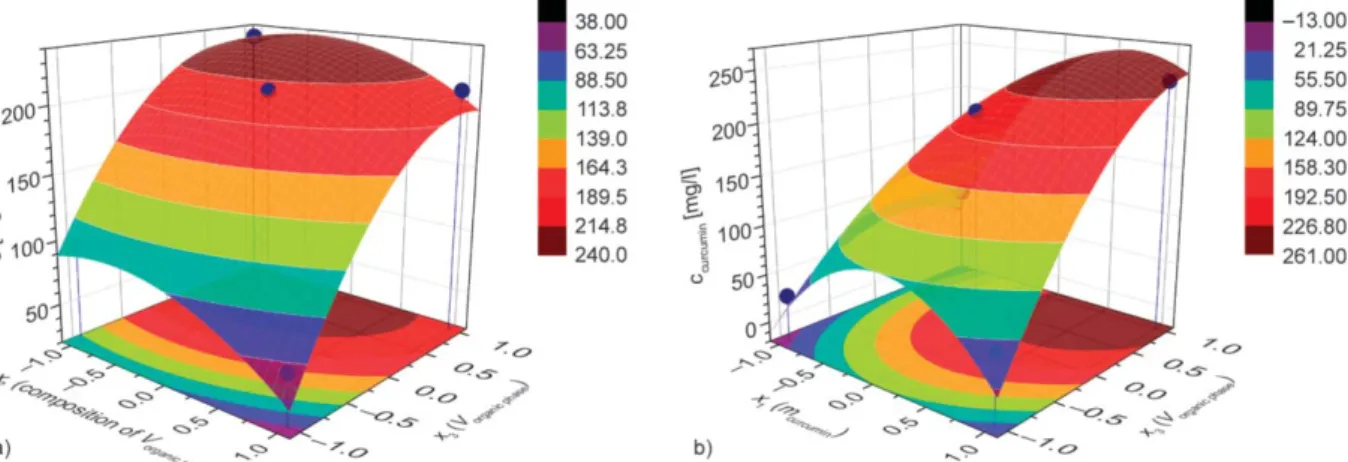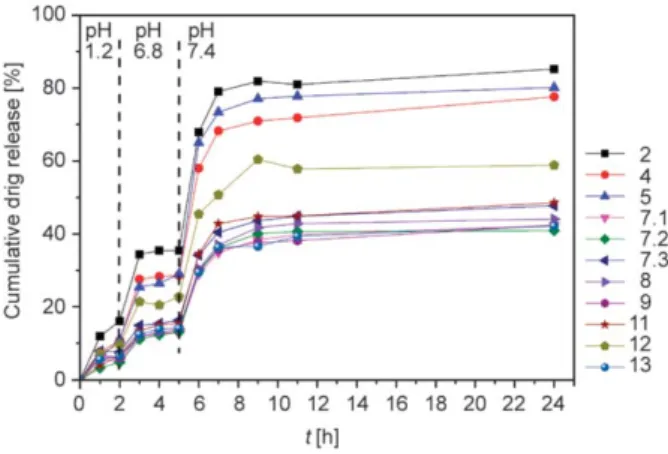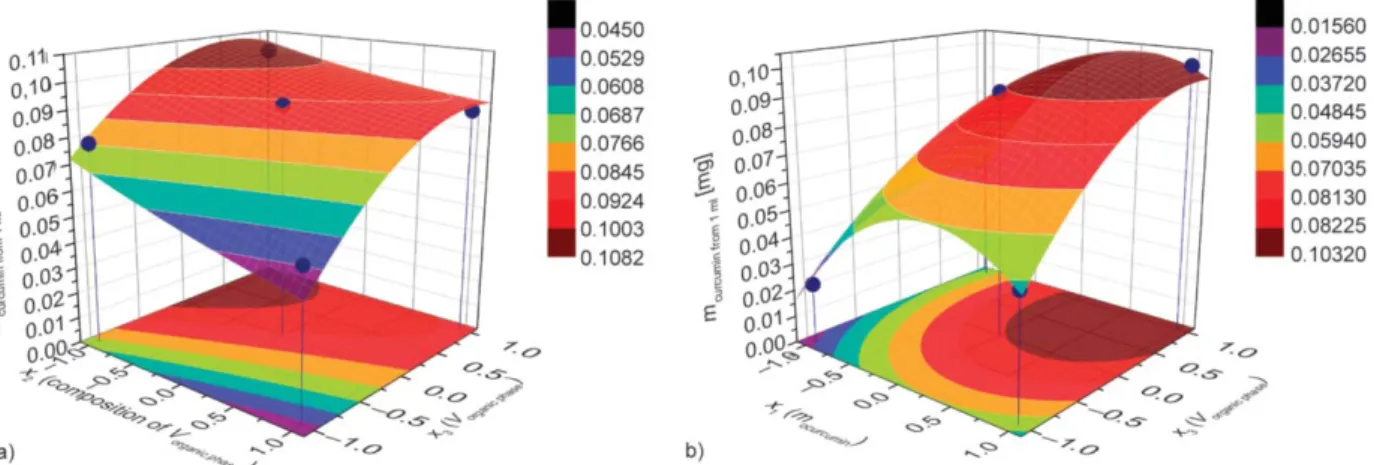1. Introduction
In recent years, significant interest has been focused on nanotechnology-based drug delivery systems be- cause of their promising potentials and advantages over conventional approaches. Colloidal drug deliv- ery systems such as liposomes, nanocapsules, micel- lar systems and conjugates have been used exten- sively in the last decades to increase therapeutic benefit of drugs while minimizing their side effects
[1–3]. The nanoparticulate carrier systems provide high dispersity and increased bioavailability of the bioactive compound while allowing controlled re- lease and targeting. They can be utilized in injectable or oral formulations, and in bioadhesive systems as well. The delivery of several therapeutic compounds can be hindered by their poor aqueous solubility. The nanocarrier systems are especially advantageous in the case of highly hydrophobic drug molecules, such
Highly efficient encapsulation of curcumin into and pH-controlled drug release from poly(ε-caprolactone) nanoparticles stabilized with a novel amphiphilic
hyperbranched polyglycerol
N.Zs. Nagy1, Z. Varga2, J. Mihály2,Gy. Kasza3, B. Iván3, É. Kiss1*
1Laboratory of Interfaces and Nanostructures, Institute of Chemistry, Eötvös Loránd University, Hungary, H-1518 Budapest 112, PO Box 32, Hungary
2Biological Nanochemistry Research Group, Institute of Materials and Environmental, Chemistry, Research Centre for Natural Sciences, Hungarian Academy of Sciences, H-1117 Budapest, Magyar tudósok körútja 2, Hungary
3Polymer Chemistry Research Group, Institute of Materials and Environmental, Chemistry, Research Centre for Natural Sciences, Hungarian Academy of Sciences, H-1117 Budapest, Magyar tudósok körútja 2, Hungary
Received 17 April 2019; accepted in revised form 23 July 2019
Abstract.The hardly water-soluble curcumin with low bioavailability was successfully encapsulated into biodegradable polymeric particles by nanoprecipitation. By using the more hydrophobic poly(ε-caprolactone) (PCL) instead of poly(lac- tic-co-glycolic acid) 50:50 (PLGA) significantly increased drug load was achieved. The stronger interaction between cur- cumin and PCL than PLGA was supported by Fourier-transform infrared spectroscopy (FTIR) measurements. As efficient colloid stabilizer, a novel amphiphilic polymer, hyperbranched polyglycerol with one long alkyl chain (C18-HbPG) was used which has better membrane affinity than the widely used Pluronics, and it enables further functionalization of the drug carrier as well. A Box-Behnken experimental design was applied to prepare and optimize the properties of curcumin loaded PCL nanoparticles (NPs) varying the initial drug load, composition of the organic phase and volume ratio of aqueous and organic phases. The volume of the organic phase was found to be the most relevant parameter for encapsulation, and it can be used to control the size and drug content of the NPs. The curcumin load of 10 w/w% of the NPs with diameter below 120 nm was observed in the optimal system. Cumulative controlled release of curcumin with strong pH-dependence into simulated gastric fluids with up to ~80% is found after 8–12 hours.
Keywords:nanomaterials, curcumin, drug carrier, polycaprolactone, hyperbranched polyglycerol https://doi.org/10.3144/expresspolymlett.2020.8
*Corresponding author, e-mail:kisseva@caesar.elte.hu
© BME-PT
as curcumin, which are hardly soluble in water with low bioavailability.
Curcumin is known over 5000 years as a traditional medicine and spice. The poly-phenolic bioactive com- pound is isolated from the rhizome of the Curcuma longa plant. It is one of the most intensively studied natural active substances, because it has been de- scribed to have numerous health benefits such as anti- cancer, anti-fungal, antiviral, antioxidant, anti-angio- genic and anti-inflammatory properties [4]. It also shows activity in chronic diseases, such as diabetes type II, rheumatoid arthritis, various skin diseases, Alzheimers’ disease, multiple sclerosis, and major depressive disorder and atherosclerosis [5]. The main problems of the curcumin usage are low bioavail- ability based on low solubility in water (<0.01 mg/l) [6, 7], poor absorption, rapid metabolism and fast elimination from the body.
Encapsulation of curcumin into polyester type bio- compatible and biodegradable polymers is consid- ered as one of the advantageous choices in the pro- duction of a variety of micro- and nanocarrier systems [8]. Among the various Food and Drug Administra- tion (FDA) approved aliphatic polyesters, poly(lactic acid) (PLA) and various poly(lactic-co-glycolic acid) copolymers (PLGA) have been applied intensely as potential delivery systems [9, 10] due to their desir- able characteristics like non-toxicity and controlled degradation. Applying such polymers as drug carrier matrices is expected to lead to overcoming the phar- maceutical issues related to curcumin delivery by en- hancing the dissolution rate, prolonging the residence in plasma, improving the pharmacokinetic profile and the cellular uptake [11].
Most of the curcumin loaded polymeric nanoparti- cles are based on PLGA [12, 13], because it degrades fast, although the release pattern is far from ideal.
Burst release is often observed [14] which also de- pends on the polymeric stabilizer applied as surface coating of the drug delivery particles, since initial burst is mostly related to rapid release of surface as- sociated drug molecules. The fact that polyester par- ticles for curcumin delivery are mainly in the size range of several hundreds of nanometers obtained generally by emulsion technique, is a further limita- tion in pharmaceutical applications [13, 15].
Another member of biodegradable aliphatic poly- esters is poly(-ε-caprolactone) (PCL) which is used relatively seldom as drug carrier system, although it provides a great potential due to its high permeability
to many drugs and a lack of toxicity [14, 16]. The few curcumin loaded PCL systems reported include mi- celles of its copolymers [17, 18] as well as fibrous wound dressing with antioxidant and anti-inflamma- tory properties [19, 20]. The curcumin carrying PCL particles which represent higher stability than the self-associated ones are prepared recently by emul- sion technique with a size above 500 nm [21]. PCL like PLGA is suitable for controlled drug delivery due to its excellent biocompatibility and ability to be fully excreted from the body once bioresorbed. PCL however, has also the advantage of the absence of generation of acidic environment during degradation as compared to polylactides and glycolides [22].
PCL is more hydrophobic than PLGA [23], so it can be a reasonable choice as matrix for the encapsula- tion of highly hydrophobic drugs.
The present work aims at carrying out systematic in- vestigations related to the efficient nanoencapsula- tion of curcumin as a model of hydrophobic bioac- tive ingredients. Nanoprecipitation was applied as a preparation method to achieve the low particle size (d< 200 nm) with narrow size distribution. The drug content of the nanoparticles was planned to be in- creased by the utilization of enhanced drug-matrix interaction expected between the highly hydrophobic curcumin and PCL, which has different structure and physicochemical properties compared to the mostly used PLGA. A novel amphiphilic polymer, a hyper- branched polyglycerol (HbPG) with one long alkyl chain was selected for the surface coating of the cur- cumin loaded PCL nanoparticles (NPs) since this polymer was found by us previously to be an effi- cient steric stabilizer [24]. Besides the stabilization of NPs against aggregation, this polymer also pro- vides high number of surface functional groups al- lowing further coupling of labels or targeting moi- eties [25]. In order to get an overall picture on the various experimental parameters of nanoprecipita- tion affecting the encapsulation of curcumin an ex- perimental design was applied. The individual and combined influence of three parameters, namely the drug loading, the composition of the organic phase and the ratio of organic/aqueous phase were ana- lyzed using a three level three factorial fractional ex- perimental design [26]. Significance levels allow the identification of relevant parameters influencing the particle size, drug content of NPs and the achievable nanosized drug content in the aqueous phase. Re- lease of curcumin was also measured in vitro using
fluids simulating the gastrointestinal tract, and the results are compared for the different systems.
2. Materials and methods 2.1. Materials
Curcumin (MW= 368.38 g/mol; purity ≥ 65% by HPLC) and poly(D,L-lactide-co-glycolide) (PLGA 50:50; MW= 30–60 kDa) were purchased from Sigma-Aldrich (St. Louis, Missouri, United States).
Pluronic®F-127 (MW= 12.6 kDa) was a kind gift from BASF, Hungary. Sodium dodecyl sulphate (SDS; MW= 288.37 g/mol; ≥99% AnalaR NORMA- PUR) was purchased from VWR International Kft.
(Hungary) while sodium chloride, sodium hydrox- ide, potassium dihydrogen phosphate, disodium hy- drogen phosphate from Sigma-Aldrich (St. Louis, Missouri, United States) were of analytical grade.
Tetrahydrofuran (THF), methanol, ethanol, acetone, hydrochloric acid were of laboratory grade from Molar Chemicals Kft. (Hungary). Poly(ε-caprolac- tone), PCL (MW= 10 000–20 000), Polysciences Inc., (USA) and pepsin were pharmaceutical products.
Hyperbranched polyglycerol with one octadecyl group (C18) (C18-HbPG) was synthesized previous- ly [27]. Briefly, 10% of the hydroxyl groups of oc- tadecyl alcohol were deprotonated by equivalent amount of potassium methoxide at 40 °C under inert atmosphere for 30 min, followed by the removal of the formed methanol by applying vacuum. Subse- quently, ring-opening multibranching polymeriza- tion of glycidol was carried out via slow monomer addition at 95 °C to obtain C18-HbPG (Mn= 3750 g/mol, PDI = 1.5).
2.2. Methods
2.2.1. Preparation of the nanoparticles
The nanoparticles were prepared by nanoprecipita- tion. PLGA or PCL was dissolved in an organic sol- vent (THF, acetone or their mixture) to a concentra- tion of 20 mg/ml. In the case of drug loaded nanopar- ticles, the varying amount of curcumin was dissolved in the organic solvent. The polymeric stabilizer (F127 or C18-HbPG) was dissolved in water to a concen- tration of 2 mg/ml. The organic solution was rapidly added to the aqueous solution under magnetic stir- ring. The solutions were continuously stirred overnight to evaporate the organic solvent. The sol (colloidal system consisting of nanosize solid parti- cles disperesed in a liquid medium) was centrifuged at 6000 rpm for 10 minutes to eliminate the excess
drug and the possible large polymeric aggregates.
The sol was dialysed against aqueous ethanol (10 V/V%) for 48 hours in 50 kDa MWCO pore size membrane bags. Drug loaded NPs were stored in aqueous medium or in liophilized form at 4 °C.
2.2.2. Box-Behnken experimental design
A three factorial three level fractional experimental Box-Behnken design was applied to determine the importance of variables influencing the efficacy of encapsulation. According to that each factor or inde- pendent variable is placed at one of three equally spaced values, usually coded as –1, 0, +1. The ex- perimental design for 3 factors involves three blocks, in each of which 2 factors are varied through the 4 possible combinations of high and low levels. It is necessary to include centre point as well [26]. In this case we have 13 points represented in Figure 1 in- cluding the centre point at which the experiment is repeated 3 times. The independent variables and their values are shown in Table 1.
Samples prepared under the set of experimental con- ditions were characterized by determining their prop- erties and the drug content of the NPs. Evaluating the experimental data we got 10 coefficients (marked as Table 1.The independent variables and their values.
Table 2.Measuring points with their values.
Factors Levels/Values
–1 0 +1
x1(mcurcumin) [mg] 2 4 6
x2 (composition of organic phase)
99% acetone + 1% THF
50% acetone + 50% THF
1% acetone + 99 % THF
x3(Vorganic phase) [ml] 1 2.5 4
Measuring points
x1
(mcurcumin) [mg]
x2
(composition of organic phase)
x3
(Vorganic phase) [ml]
1 –1 0 –1
2 –1 –1 0
3 –1 +1 0
4 –1 0 +1
5 0 –1 –1
6 0 +1 –1
7 0 0 0
8 0 –1 +1
9 0 +1 +1
10 +1 0 -1
11 +1 –1 0
12 +1 +1 0
13 +1 0 +1
b) of a quadratic formula which shows the influence and relative importance of the independent variables.
y=b0+ b1x1+ b2x2+ b3x3+ +b11x12 + b22x22 + b33x32
+ + b12x1x2+ b23x2x3+ b13x1x3
The coefficients can be calculated for different target functions (marked as y). In this study our target func- tions are the effective diameter of the nanoparticles (y1), zeta potential (y2), curcumin concentration in water (y3), the curcumin content of NPs [%] (y4) and the curcumin release (y5).
2.2.3. Characterization of curcumin loaded nanoparticles
FTIR spectroscopy
Mid-IR (400–4000 cm–1, 128 scans, and resolution 4 cm–1) absorption spectra were recorded using a dy- namically aligned Varian 2000 FTIR spectrometer (Varian Inc., USA) equipped with a liquid nitrogen cooled broadband MCT detector. Spectra were recorded using a ‘Golden Gate’ micro-ATR accesso- ry (Specac Ltd., UK) with KRS-5 lenses and a dia- mond ATR element. 5 μl of sample solution was mounted on the ATR crystal and a thin dry film was obtained by evaporation of the aqueous solvent under ambient conditions. The measurements were per- formed at room temperature, immediately after dry- ing the sample (within approximately 5 min). All IR spectra were ATR corrected. IR spectra were processed and evaluated with the GRAMS/AI (7.02) spectroscopy software suite.
Dynamic light scattering
Average hydrodynamic diameter and polydispersity of the nanoparticles were determined using a dynam- ic light scattering (DLS) system (Brookhaven Instru- ments, USA). The device consisted of a BI-200SM
goniometer and a BI-CrossCor cross correlation digital autocorrelator. A Coherent Genesis MX488- 1000 STM monomodal laser was used as light source at a wavelength of 488 nm. The device was connect- ed to a Techne TU-20D programmable circulating thermostat to ensure appropriate temperature control.
All of the autocorrelation functions were measured at θ = 90°. Measurements were carried out at tem- perature of 25 °C. The measured correlation function was analyzed by the second-order cummulant meth- ods. The apparent mean diffusion coefficient of the particles (Dapp) was determined at finite concentra- tions and q-values. The apparent hydrodynamic ra- dius of the particles could be obtained by using Stokes-Einstein Equation (1):
(1) where kis the Boltzmann-constant, Tis the thermo- dynamic temperature, μ is the viscosity of the medi- um and Dappis the apparent mean diffusion coeffi- cient.
DLS measurements were done on dilute solutions (50 ppm) and the samples were equilibrated for an hour prior to the measurements at a given tempera- ture. At least fifteen parallel measurements were done in each case.
Zeta potential
The measurement of electrophoretic mobility of nano - particles was carried out by a Malvern Zetasizer Nano Z (Malvern Panalytical Ltd., UK) apparatus at 25 °C.
Smoluchowski approximation was used to calculate zeta potential from mobility values. Particles were surveyed in aqueous salt solution with constant ionic strength (2 mM NaCl). Each measurement was re- peated three times.
Drug content
To determine the drug content, the sols were dried in vacuum. The dry nanoparticles were dissolved in acetone and the absorbance was measured spectro - photometrically (Specord 40, Analytik Jena AG, Ger- many) at 427 nm. Each measurement was repeated three times. The drug concentration, ccurcumin[mg/l]
is calculated for the liquid medium of the nanoparti- cles, while the drug content [%] is calculated for the dried NPs by the following formula:
R kTD
6
h= rn app
mm
NPs 100
curcumin $ Figure 1.Representation of the measuring points.
2.2.4. In vitrodrug release and release kinetics The in vitrocurcumin release from the PCL nanopar- ticles was investigated by dialysis [13] for which 3 ml of each sample was transferred into 12–14 kDa dialysis bag. The bags were suspended into 50 ml re- lease medium. The release medium was constantly stirred with 100 rpm and kept at 37±0.5 °C. Samples were withdrawn and replaced with fresh solution at appropriate time intervals from the outer solution to determine the percentage of the drug released. To mimic the in vivocurcumin release characteristics from the nanoparticles we applied the following time interval and medium:
Stage 1 – Simulated gastric fluid
0–2 hours; pH 1.2; 0.2 g NaCl, 0.32 g pepsin, 0.7 ml cc HCl in 100 ml water
Stage 2 – Simulated intestinal fluid
2–5 hours; pH 6.8; 0.68 mg KH2PO4, 7.7 ml of 0.2 M NaOH in 100 ml water
Stage 3 – Simulated colonic fluid 5–24 hours; pH 7.4; phosphate buffer
The different release media contained 2% SDS to maintain sink condition and also to provide solubil- ity for curcumin in the aqueous phase. The drug con- tent was determined spectrophotometrically.
3. Results and discussion
3.1. Orienting encapsulation experiments Preliminary experiments were performed with PLGA and PCL for curcumin nanoencapsulation.
Nanoparticles were formed using acetone as organic solvent and two polymeric stabilizers, Pluronic127 or C18-HbPG, were compared for the PCL NPs. The structure of the components of the NPs is depicted in Figure 2.
The main properties of these systems are summa- rized in Table 3. The data show that the particle size is below 200 nm.
The zeta potential for PCL NPs is lower than for PLGA 50:50 applying the same stabilizer which is in accordance with the chemical composition of the polyesters. It is also shown by the zeta potential val- ues that C18-HbPG forms a thinner layer on the PCL particle than Pluronic F127 does. It was proven pre- viously that this thinner C18-HbPG layer can suffi- ciently protect the NPs against aggregation [24]. The most notable difference between PLGA and PCL ob- tained is the amount of curcumin dispersed in the aqueous phase. The increase in this quantity is more
than tenfold, which indicates that PCL is a promising matrix for the nanoencapsulation of curcumin.
3.2. Curcumin-polymer interactions: FTIR spectroscopic investigation
ATR FTIR spectra (wavenumber region of 1900–
800 cm–1) of curcumin loaded polymer nanoparticles (NP) stabilized by C18-HbPG and that of pure cur- cumin are shown in Figure 3. Both curcumin and the polymers have characteristic bands in this spectral region. Curcumin (spectrum recorded from ethanol solution) has a medium intensity band at 1625 cm–1, due to C=C and C=O stretching vibrations (νC=C and νC=O) of the inter-ring chain. The band at 1586 cm–1belongs to the C=C stretching of aromatic rings. The most intense curcumin band is at 1511 cm–1 and is a combination of C=O stretching, and CCC Figure 2.The components of curcumin loaded PLGA 50:50 or PCL based nanoparticles for which C18-HbPG serves as particle stabilizer.
Table 3. The main properties.
Diameter (d), polydispersity (PD), zeta potential (ζ) and curcumin concentration in the aqueous phase (ccurcumin) of curcumin loaded nanoparticles formed from PLGA 50:50 and PCL, stabilized by PluronicF127 or C18-HbPG.
Polymer Stabilizer d
[nm] PD ζ
[mV]
ccurcumin
[mg/l]
PLGA 50:50 F127 120 0.111 –11.3 1.5
PCL F127 176 0.091 –0.9 27.9
PCL C18-HbPG 176 0.127 –10.2 37.4
and CC=O bending vibrations, respectively. The medium intensity band around 1282 cm–1is assigned to the C–H bending of C=CH moieties and the band at 967 cm–1might belong to the –OH deformation of enolic group [28]. As to the polymers, the main bands belong to the ester moieties of PLGA and PCL, namely νC=O and νC–O–C at 1759 and 1095 cm–1, and 1730 and 1105 cm–1, respectively.
For curcumin loaded PLGA, the presence of cur- cumin can be witnessed by the appearance of a small curcumin band at 1511 cm–1in the spectrum. The rel- ative intensity changes of bands in 1500–1300 cm–1 spectral region, mainly belonging to C–H deforma- tions of PLGA, however, suggest that the curcumin is located in the environment of the PLGA mole- cules. In case of the curcumin loaded PCL the inten- sities of the curcumin bands are significantly higher suggesting higher loading. In this case, some shift of the PCL bands is also observed. Particularly, the band corresponding to C–O–C stretching of PCL at 1100 cm–1 wave number was increased and shifted to 1105 cm–1. The shift of antisymmetric C–O– C streching towards higher wavenumber suggests that H-bonds might be formed between the polymer chain and the drug. We have to point out, however, that bands of the C–O–C groups of the stabilizer C18-HbPG added have also contributions to this wave number region. Some other small bands shifted slightly, too. These changes in the curcumin loaded PCL spectrum might be caused by interaction be- tween the drug and the polymer main chain.
For a better evaluation of the loaded curcumin con- tent, difference spectra were created. After normal- ization to the highest C=O stretching band of the
polymer, the pure polymers spectra were subtracted from the curcumin loaded one (Figure 4). Based on the intensity of the characteristic curcumin band at 1511 cm–1, roughly 4 times higher curcumin is loaded in PCL than in PLGA. The difference be- tween the curcumin-PCL and curcumin-PLGA inter- actions is further revealed by detailed analysis of the subtracted/difference spectra (Figure 4). For the cur- cumin loaded PLGA spectrum a new C=O stretching band appears (not present in pure polymer spec- trum). This band belongs to the population of car- bonyl groups involved in H-bonding due to the pres- ence of curcumin. No such spectral feature was observed for PCL indicating that curcumin may not located in the vicinity of the carbonyls in this poly- mer but rather the hydrophobic part is involved. In- deed, in the case of PCL the vibrational bands in the 1300–1000 cm–1wave number region are affected.
These bands correspond mainly to methylene bend- ing and wagging (δCH2) and C–O/C–C stretching Figure 3.FTIR spectra in the fingerprint region: spectrum of curcumin-loaded PLGA nanoparticles compared with that of pure curcumin and PLGA (a) and spectrum of curcumin-loaded PCL nanoparticles compared with that of pure curcumin and PCL (b).
Figure 4.Difference spectra of curcumin loaded NPs (the spectrum of the corresponding pure polymer was subtracted from curcumin loaded NPs).
(νC–-O/C–C) of the polymer skeletal structure and their appearance in the difference spectrum further confirms the affinity of curcumin towards hydropho- bic part. (We have to note the characteristic bands of stabilizer C18-HbPG at 1150–1000 cm–1(C–O–C stretching), at 949 cm–1 (CH2 twisting) and at 848 cm–1(CH2rocking) in the difference spectra in Figure 4.)
3.3. Systematic study of curcumin
encapsulation into PCL NPs by using the Box-Behnken experimental design
Preliminary tests, as discussed in the previous sec- tions, with the variation of PLGA/PCL – F127/HbPG systems led us to choose the PCL and C18-HbPG as matrix and stabilizer polymers, respectively. We were curious about the influence of selected experi- mental conditions of nanoprecipitation on the size of formed particles and their curcumin content which could be achieved. Experimental factors, x1, x2and x3
and their values were set according to Tables 1 and 2.
The measured response values related to the size and drug content of the NPs as well as the released amount are summarized in Table 4.
3.3.1. Size of the nanoparticles
It was found that the diameter of the nanoparticles is well below 200 nm for the whole series of systems.
The measured values are in the range 95–170 nm over the selected scale of experimental parameters.
The polydispersity indices are around 0.1 or below, which means narrow size distribution in diameter.
The three parallel midpoint samples in the experi- mental design (123.6; 122.0; 123.3 nm) show good match. The calculated response function for the di- ameter (y1) is the following quadratic formula (Equa- tion (2)) with the coefficients:
(2) The coefficients >2.42 are significant (conf.int.: 95%) which means that the composition of the organic phase, x2and its volume, x3have considerable effect on the size of the NPs.
The response surface presenting the effect of com- position (x2) and volume of organic phase (x3) is dis- played in Figure 5.
According to the response polynomial function, the particle size is somewhat larger by applying THF in the organic phase compared to the acetone rich phase.
More unexpectedly, the higher amount of organic phase in the precipitating mixture leads to reduced particle size. This can be in connection with the pre- cipitation process in a liquid medium, which is less bad solvent for the PCL and curcumin than that formed from 10 ml of water and 1 ml of organic sol- vent (x3= –1).
. . .
. . .
. . .
y x x x
x x x
x x x x x x
123 2 47 19 51 21 08 2 74 2 46 13 41
2 95 762 1 1
1 1 2 3
12
22
32
1 2 2 3 1 3
= - + - +
+ + + -
- + -
Table 4.Measuring points of the experimental design.
The determined response values of diameter (d), polydispersity (PD), curcumin concentration in the aqueous phase (ccurcumin), curcumin content of nanoparticles [%] formed and curcumin released after 24 h.
Measuring
points x1 x2 x3 d
[nm] PD ccurcumin
[mg/l]
Curcumin content [%]
Curcumin released after 24 h [mg/ml]
1 –1 0 –1 167.1 0.106 27.0 2.0 0.027
2 –1 –1 0 106.1 0.103 70.4 2.5 0.060
3 –1 +1 0 152.7 0.093 49.3 2.3 0.049
4 –1 0 +1 118.9 0.113 78.6 2.7 0.061
5 0 –1 –1 144.8 0.102 97.1 4.6 0.078
6 0 +1 –1 166.9 0.140 57.2 3.0 0.006
7.1 0 0 0 123.6 0.081 211.1 10.1 0.089
7.2 0 0 0 122.0 0.085 225.0 8.6 0.092
7.3 0 0 0 123.3 0.087 191.3 8.5 0.091
8 0 –1 +1 95.6 0.099 231.7 7.4 0.102
9 0 +1 +1 148.2 0.068 207.5 8.0 0.088
10 +1 0 –1 161.7 0.125 46.8 4.1 0.047
11 +1 –1 0 109.7 0.101 202.8 6.9 0.099
12 +1 +1 0 144.5 0.088 139.9 8.2 0,082
13 +1 0 +1 109.1 0.093 236.2 9.5 0.100
3.3.2. Zeta potential
Zeta potentials for the PCL nanoparticles as expected are negative values because of the carboxylic end groups of the polymer. The charged surface is covered by the stabilizer layer formed from the neutral highly branched polyglycerol molecules reducing the ab- solute value of the zeta potential. The average of zeta potential for the measured systems is –16±6 mV. The examined experimental parameters had no explicit in- fluence on this property of the NPs. None of the cal- culated coefficients reached the level of significance.
3.3.3. Curcumin concentration
The curcumin loading efficiency can be expressed in two forms. One of the target functions is the cur- cumin concentration in water [mg/l] (y2), while the other is the curcumin content of the NPs [w/w%] (y3).
The calculated quadratic formulas (Equations (3) and (4)) are as:
(3)
(4) where the significance level for the coefficients are 10.67 and 0.57 for y2and y3respectively, accounting with 95% confidence. According to these findings, the initial amount of curcumin dissolved in the organic phase (x1) and the amount of the organic phase in the nanoprecipitation (x3) process are the main parame- ters which have great impact on the curcumin con- centration in the NPs. The relation that the higher initial loading of curcumin results in higher amount of dispersed curcumin is reasonable. However, the degree of increase is lower than expected, which is probably due to the loss of the drug, especially at the first centrifugation cleaning process. The high values of coefficients in terms containing x3 indicate the strong influence of the volume of organic phase. This means that the higher the organic solvent concentra- tion in the precipitation medium more curcumin will be encapsulated in the NPs. Since y3represents the drug content of the NPs, y2and y3are interrelated, and the dominant factors are the same. Maximum drug content, around 10% can be achieved by in- creasing the initial amount of curcumin, and more importantly, by increasing the organic content of the precipitating solution.
By using the calculated coefficients, the response sur- face can be created for each target function. Figure 6
. . . .
. . .
. . .
y x x x
x x x
x x x x x x
209 1 50 05 18 52 65 74 72 38 21 17 396
10 43 3 9 34 47
2 1 2 3
12
22
32
1 2 2 3 1 3
= + - + -
- - - -
- + +
. . . .
. . .
. . .
y x x x
x x x
x x x x x x
9 1 2 39 0 007 1 47 265 1 46 1 85
0 365 1 3 1 16
3 1 2 3
12
22
32
1 2 2 3 1 3
= + + + -
- - - -
+ + +
Figure 5.Calculated response surface representing the pre- dicted values of particle diameter (d) displayed as a function of x2and and volume of organic phase x3.
Figure 6.The response surfaces for the curcumin concentration in water, y2as a function of composition, x2and volume of organic phase, x3(a), and initial curcumin amount, x1and volume of organic phase, x3(b).
shows the response surfaces of the concentration of the drug in the aqueous sol. On the curcumin con- centration in water, the x1(mcurcumin[mg]) and the x3(Vorganic phase[ml]) factors have strong impact; the type of the organic phase does not count much as the surface shows (Figure 6a), although there is a slight preference of acetone rich phases. The most favourable region of the experimental parameters resulting in curcumin concentration in water well above 200 mg/l corresponds to the highest value of the organic phase.
In this set of experiments, this means 4 ml of organic solution of curcumin and PCL added to 10 ml of water containing the C18-HbPG stabilizer. The influence of the organic phase’s volume can be explained by the results of a previous research dealing with the development of a method for the prediction of drug content of NPs [29]. The beneficial character of the condition with high organic content can be associated to the previously described relation between the na- noencapsulation efficiency and the combined influ- ence of hydrophobicity and solubility of the drug. Ac- cording to these findings, the increased solubility of the drug in the medium can enhance the encapsula- tion. This seems to be valid under the applied solvent conditions, according to which the nanoprecipitation of the curcumin and PCL is shifted towards the co- precipitation compared to the other medium (1 ml or- ganic phase mixed with 10 ml of aqueous phase).
3.3.4. In vitro drug release and release kinetics The in vitro drug release experiments were used to calculate the cumulative values plotted for the vari- ous samples in Figure 7. (Some of the samples (1; 3;
6; 10) cannot be displayed due to their low drug con- tent.) In the first medium (simulated gastric fluid, pH 1.2), mostly the surface bounded drug has been released. At the higher pH levels (simulated intestin- al fluid, pH 6.8; simulated colonic fluid, pH 7.4), higher amounts of the drug were released. The two steps at the 2ndand the 5th hours are caused by the switch of the release media. The cumulative drug re- lease for 24 hours is between 40 and 80% for most of the NP systems. It can also be observed that only small amount of drug appeared in the fluid simulat- ing the acidic environment of stomach, while the highest amount of curcumin can reach and is re- leased into the simulated colonic fluid.
Another representation of the drug release however provides further information on the potential of the different samples of encapsulated curcumin. The re-
leased amount of curcumin in mg quantities from 1 ml of drug loaded NP suspension is displayed in Figure 8. This type of representation reflects also on the initial drug content of the different samples not only the release properties. It is an interesting point that high released amount of curcumin can be ob- tained from systems possessing high drug content (samples 8, 11, 13) although their cumulative release values [%] were weaker. Similarly, the high cumu- lative release (typically systems 2 and 4) does not necessarily mean increased concentration of curcum- in in the release medium.
The evaluation and discussion of the release results is also possible by the analysis of the quadratic equa- tion calculated for the experimental points of the de- sign. The target function (Equation (5)) was the total amount of curcumin [mg] released from 1 ml NP suspension after 24 hours:
Figure 7.The cumulative drug release from the curcumin loaded PCL NPs into simulated gastric fluids mod- elling three tracts of digestive system (The number of curves corresponds to the systems prepared under different conditions listed in Table 4.).
Figure 8.The released amount of curcumin (mg) from 1 ml NP suspension into simulated gastric fluids mod- elling three tracts of digestive system (The number of curves corresponds to the systems prepared under different conditions listed in Table 4.).
(5) The coefficients >0.0099 can be considered signifi- cant. The response surfaces are shown to demonstrate the impact of various parameters in Figure 9.
The most relevant parameters influencing the total amount of curcumin released are the volume of or- ganic phase and the initial curcumin load. The cur- cumin released is obviously increased by larger ini- tial load, but more importantly, by the proper choice of the precipitation condition (higher x3). It is inter- esting to note, that there is a similarity in the relative importance of experimental factors in equation for y2and y4determining the encapsulated and released amount of drug, respectively. This finding supports that the nanoencapsulated form of curcumin is ad- vantageous because it becomes available in the re- lease medium.
4. Conclusions
The main purpose of the present research was to en- capsulate curcumin into polyester type nanoparticles with increased drug content. PCL is a member of biodegradable and biocompatible polyesters with more hydrophobic character than PLGA, and gener- ating less acidic environment due to its degradation.
Therefore, PCL was selected as a carrier polymer for a highly hydrophobic molecule curcumin. The ex- pected enhanced interaction between the polymer matrix and the drug was demonstrated by FTIR in- vestigations. In vitrodrug release experiments showed that this preferred interaction does not hinder the ef- ficient release of the drug from the PCL NPs. The
drug content of the NPs and the amount of highly dispersed curcumin in the aqueous phase were man- aged to be increased significantly by revealing that the composition of the precipitating medium is of paramount importance. The proper composition of the organic phase and the increased volume of or- ganic phase related to that of the aqueous phase alter the precipitation conditions favouring the coprecip- itation of the drug with the matrix polymer leading to high drug content of the nanoparticles with small sizes.In vitrodrug release studies in simulated gastric fluids with a sequence of pH values of 1.2, 6.8 and 7.4 show that low amount of drug release occurs at pH 1.2 and 6.8, while increased extent of slow release is observed at pH = 7.4. These findings indicate that PCL nanoparticles are promising drug carrier matri- ces for dominant drug release in the alimentary canal.
It was also found that a novel amphiphilic polymer, C18-HbPG, applied as stabilizer of drug loaded NPs, provides outstanding colloidal stability, and its sub- sequent functionalization is an additional benefit, for obtaining stabilized NPs with desired sensoring and targeting moieties.
The results of this study are expected to contribute to successful nanoencapsulation of a large variety of hydrophobic drug compounds resulting in their in- creased bioavailability.
Acknowledgements
This work was completed in the ELTE Institutional Excellence Program (1783-3/2018/FEKUTSTRAT) supported by the Hungarian Ministry of Human Capacities and VEKOP-2.3.2- 16-2017-00014 supported by National Research Development and Innovation Office, Hungary. The authors thank Csaba Németh for his help in performing and evaluation of the ATR FTIR measurements. This work was also supported by the BIONANO_GINOP-2.3.2-15-2016-00017 project.
. . . .
. . .
. . .
y x x x
x x x
x x x x x x
0 091 0 018 0 0095 0 018 0 022 0 0014 0 0118 0 001 0 0025 0 0043
4 1 2 3
12
22
32
1 2 2 3 1 3
= + - + -
- + - +
+ + +
Figure 9.The response surfaces for the curcumin release as a function of composition, x2and volume of organic phase, x3(a), and curcumin amount and volume of organic phase, x3(b).
References
[1] Hegedüs R., Manea M., Orbán E., Szabó I., Kiss É., Sipos É., Halmos G., Mező G.: Enhanced cellular up- take and in vitro antitumor activity of short-chain fatty acid acylated daunorubicin–GnRH-III bioconjugates.
European Journal of Medicinal Chemistry, 56, 155–165 (2012).
https://doi.org/10.1016/j.ejmech.2012.08.014
[2] Kiss É., Schnöller D., Pribranská K., Hill K., Pénzes Cs. B., Horváti K., Bősze Sz.: Nanoencapsulation of antitubercular drug isoniazid and its lipopeptide conju- gate. Journal of Dispersion Science and Technology, 32, 1728–1734 (2011).
https://doi.org/10.1080/01932691.2011.616128
[3] Varga N., Hornok V., Janovák L., Dékány I., Csapó E.:
The effect of synthesis conditions and tunable hydro - philicity on the drug encapsulation capability of PLA and PLGA nanoparticles. Colloids and Surfaces B:
Biointerfaces, 176, 212–218 (2019).
https://doi.org/10.1016/j.colsurfb.2019.01.012
[4] Flora G., Gupta D., Tiwari A.: Nanocurcumin: A prom- ising therapeutic advancement over native curcumin.
Critical Reviews™ in Therapeutic Drug Carrier Sys- tems, 30, 331–368 (2013).
https://doi.org/10.1615/CritRevTherDrugCarrierSyst.
2013007236
[5] Naksuriya O., Okonogi S., Schiffelers R. M., Hennink W. E.: Curcumin nanoformulations: A review of phar- maceutical properties and preclinical studies and clini- cal data related to cancer treatment. Biomaterials, 35, 3365–3383 (2014).
https://doi.org/10.1016/j.biomaterials.2013.12.090
[6] Pan K., Zhong Q., Baek S. J.: Enhanced dispersibility and bioactivity of curcumin by encapsulation in casein nanocapsules. Journal of Agricultural and Food Chem- istry, 61, 6036–6043 (2013).
https://doi.org/10.1021/jf400752a
[7] Jagannathan R., Abraham P. M., Poddar P.: Tempera- ture-dependent spectroscopic evidences of curcumin in aqueous medium: A mechanistic study of its solubility and stability. Journal of Physical Chemistry B, 116, 14533–14540 (2012).
https://doi.org/10.1021/jp3050516
[8] Yallapu M. M., Jaggi M., Chauhan S. C.: Polyester par- ticles for curcumin delivery. in ‘Handbook of polyester drug delivery systems’ (ed.: M. N. V Ravikumar) CRC Press, Boca Raton 651–673 (2016).
[9] Hiljanen-Vainio M., Karjalainen T., Seppälä J.: Bio - degradable lactone copolymers. I. Characterization and mechanical behavior of ε-caprolactone and lactide copolymers. Journal of Applied Polymer Science, 59, 1281–1288 (1996).
https://doi.org/10.1002/(SICI)1097-
4628(19960222)59:8<1281::AID-APP11>3.0.CO;2-9
[10] Asikainen S., Paakinaho K., Kyhkynen A-K., Hannula M., Malin M., Ahola N., Kellomäki M., Seppälä J.: Hy- drolysis and drug release from poly(ethylene glycol)- modified lactone polymers with open porosity. Euro- pean Polymer Journal, 113, 165–175 (2019).
https://doi.org/10.1016/j.eurpolymj.2019.01.056
[11] Serafini M. M., Catanzaro M., Rosini M., Racchi M., Lanni C.: Curcumin in Alzheimer’s disease: Can we think to new strategies and perspectives for this mole- cule? Pharmacological Research, 124, 146–155 (2017).
https://doi.org/10.1016/j.phrs.2017.08.004
[12] Yallapu M. M., Jaggi M., Chauhan S. C.: Curcumin nanoformulations: A future nanomedicine for cancer.
Drug Discovery Today, 17, 71–80 (2012).
https://doi.org/10.1016/j.drudis.2011.09.009
[13] Akl M. A., Kartal-Hodzic A., Oksanen T., Ismael H. R., Afouna M. M., Yliperttula M., Samy A. M., Viitala T.:
Factorial design formulation optimization and in vitro characterization of curcumin-loaded PLGA nanoparti- cles for colon delivery. Journal of Drug Delivery Sci- ence and Technology, 32, 10–20 (2016).
https://doi.org/10.1016/j.jddst.2016.01.007
[14] Chawla J. S., Amiji M. M.: Biodegradable poly(ε- caprolactone) nanoparticles for tumor-targeted delivery of tamoxifen. International Journal of Pharmaceutics, 249, 127–138 (2002).
https://doi.org/10.1016/S0378-5173(02)00483-0
[15] Kasinathan N., Amirthalingam M., Reddy N. D., Jagani H. V., Volety S. M., Rao J. V.: In-situimplant containing PCL-curcumin nanoparticles developed using design of experiments. Drug Delivery, 23, 1007–1015 (2016).
https://doi.org/10.3109/10717544.2014.927021
[16] Ramanujam R., Sundaram B., Janarthanan G., Deven- dran E., Venkadasalam M., Milton M. C. J.: Biodegrad- able polycaprolactone nanoparticles based drug deliv- ery systems: A short review. Biosciences Biotechnology Research Asia, 15, 679–685 (2018).
https://doi.org/10.13005/bbra/2676
[17] Raveendran R., Bhuvaneshwar G. S., Sharma C. P.: In vitro cytotoxicity and cellular uptake of curcumin- loaded pluronic/polycaprolactone micelles in colorectal adenocarcinoma cells. Journal of Biomaterial Applica- tions, 27, 811–827 (2013).
https://doi.org/10.1177/0885328211427473
[18] Gou M. L., Men K., Shi H. S., Xiang M. L., Zhang J., Song J., Long J. L., Wan Y., Luo F., Zhao X., Qian Z. Y.:
Curcumin-loaded biodegradable polymeric micelles for colon cancer therapy in vitroand in vivo. Nanoscale, 3, 1558–1567 (2011).
https://doi.org/10.1039/c0nr00758g
[19] Merrell J. G., McLaughlin S. W., Tie L., Laurencin C.
T., Chen A. F., Nair L. S.: Curcumin-loaded poly(ε- caprolactone) nanofibres: Diabetic wound dressing with anti-oxidant and anti-inflammatory properties. Clinical and Experimental Pharmacology and Physiology, 36, 1149–1156 (2009).
https://doi.org/10.1111/j.1440-1681.2009.05216.x
[20] Saeed S. M., Mirzadeh H., Zandi M., Barzin J.: Design- ing and fabrication of curcumin loaded PCL/PVA multi- layer nanofibrous electrospun structures as active wound dressing. Progress in Biomaterials, 6, 39–48 (2017).
https://doi.org/10.1007/s40204-017-0062-1
[21] Umerska A., Gaucher C., Oyarzun-Ampuero F., Fries- Raeth I., Colin F., Villamizar-Sarmiento M. G., Main- cent P., Sapin-Minet A.: Polymeric nanoparticles for in- creasing oral bioavailability of curcumin. Antioxidants, 7, 46–55 (2018).
https://doi.org/10.3390/antiox7040046
[22] Woodruff M. A., Hutmacher D. W.: The return of a for- gotten polymer – Polycaprolactone in the 21stcentury.
Progress in Polymer Science, 35, 1217–1256 (2010).
https://doi.org/10.1016/j.progpolymsci.2010.04.002 [23] Cai Q., Bei J., Wang S.: Relationship among drug de-
livery behavior, degradation behavior and morphology of copolylactones derived from glycolide, L-lactide and ε-caprolactone. Polymers for Advanced Technologies, 13, 105–111 (2002).
https://doi.org/10.1002/pat.161
[24] Kasza Gy., Gyulai G., Ábrahám Á., Szarka Gy., Iván B., Kiss É.: Amphiphilic hyperbranched polyglycerols in a new role as highly efficient multifunctional surface ac- tive stabilizers for poly(lactic/glycolic acid) nanoparti- cles. RSC Advances, 7, 4348–4352 (2017).
https://doi.org/10.1039/C6RA27843D
[25] Kasza Gy., Kali G., Domján A., Pethő L., Szarka Gy., Iván B.: Synthesis of well-defined phthalimide mono- functional hyperbranched polyglycerols and its trans- formation to various conjugation relevant functionali- ties. Macromolecules, 50, 3078–3088 (2017).
https://doi.org/10.1021/acs.macromol.7b00413
[26] Box G. E. P., Behnken D. W.: Some new three level de- signs for the study of quantitative variables. Techno- metrics, 2, 455–475 (1960).
https://doi.org/10.2307/1266454
[27] Kasza Gy., Stumphauser T., Nádor A., Osváth Zs., Szarka Gy., Domján A., Mosnáček J., Iván B.: Hyperbranched polyglycerol nanoparticles based multifunctional, non- migrating hindered phenolic macromolecular antioxi- dants: Synthesis, characterization and its stabilization effect on poly(vinyl chloride). Polymer, 124, 210–218 (2017).
https://doi.org/10.1016/j.polymer.2017.07.061
[28] Szegedi A., Shestakova P., Trendafilova I., Mihály J., Tsacheva I., Mitova V., Kyulavska M., Koseva N., Mo- mekova D., Konstantinov S., Aleksandrov H. A., Stetkov P., Koleva I. Z., Vayssilov G. N., Popova M.: Modified mesoporous silica nanoparticles coated by polymer complex as novel curcumin delivery carriers. Journal of Drug Delivery Science and Technology, 49, 700–712 (2019).
https://doi.org/10.1016/j.jddst.2018.12.016
[29] Tóth T., Kiss É.: A method for the prediction of drug content of poly(lactic-co-glycolic)acid drug carrier nanoparticles obtained by nanoprecipitation. Journal of Drug Delivery Science and Technology, 50, 42–47 (2019).
https://doi.org/10.1016/j.jddst.2019.01.010
